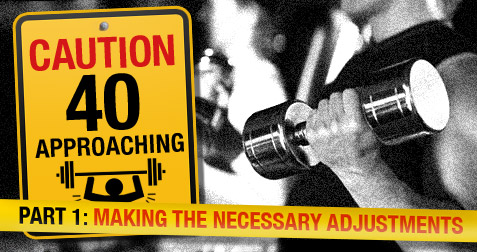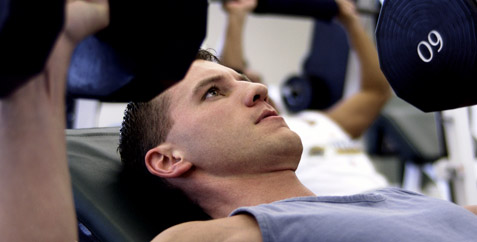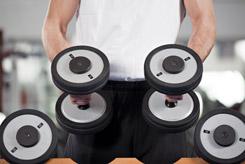
06/22/2010
Furci Home / Fitness Channel / Bullz-Eye Home
If you are approaching 40 years of age or beyond, you are probably starting to realize you can no longer train like you did in your 20s. As a matter of fact, if you’re like most, you can’t even get out of bed like you did in your 20s. Whether it’s the result of injuries, age or both, our bodies can no longer perform in the manner they once did. And if we want to continue to train hard, be healthy and improve, we must make the necessary changes. I learned this lesson the hard way.
At 36, I tore both quadricepses in seven places. The orthopedic said the MRI revealed they were mainly fascia tears not requiring surgery. Nonetheless, my legs had bruising all over them, I had to walk with crutches for a week and couldn’t squat without weight for almost two months. Eighteen weeks later, I tore my right hamstring. At 38, I had to have a partial triceps tendon tear reattached. At 39, I partially (20%-25%) tore my pec, but opted not to get surgery.
 After my last injury I finally threw in the towel. I thought my days of pushing my body to the limit with high intensity workouts were over. What was going on? From the time I was 17, I took pride in performing all exercises with perfect form. As a beginner, I took every measure to ensure I was training properly. The last thing I wanted was to train like the typical “tool” in the gym and reap sub-average results, if any. I was, and still am, a voracious reader and forever cognizant of what’s going on with my body. So, not understanding the reasons for the injuries was very frustrating.
After my last injury I finally threw in the towel. I thought my days of pushing my body to the limit with high intensity workouts were over. What was going on? From the time I was 17, I took pride in performing all exercises with perfect form. As a beginner, I took every measure to ensure I was training properly. The last thing I wanted was to train like the typical “tool” in the gym and reap sub-average results, if any. I was, and still am, a voracious reader and forever cognizant of what’s going on with my body. So, not understanding the reasons for the injuries was very frustrating.
Although all the areas I had torn had minor injuries in previous years, none of the tears had any preceding symptoms. On the days each of them occurred, I felt pain free and strong. I was ready to push my body to the limit. What made it even more perplexing was none of the injuries occurred with maximum weight. Consequently, post injury, I was training in fear that it would happen again out of the blue.
I was training with a very slow tempo, which yields insufficient loads and a less-than-optimum result. My thoughts were overwhelmed with visions of visiting the orthopedic doctor with every twinge or burn I felt while training. I was feeling horrible both physically and mentally. My mind was infested with negative thoughts, which was totally foreign to me. Instead of being positive, training smart, and doing what I should do for my body, I was too concerned with what I couldn’t do.
Almost to the day, a year after I tore my pec, I came to a crossroads. I was so frustrated with my lack of progress, which was mainly due to my pessimistic mindset, and I decided something had to give. I thought maybe I needed to accept sliding into mediocrity. I’ll start training for endurance and use plastic dumbbells and a stability ball for my weight training. Yeah, right! Sounds funny, but I was really to that point mentally. But I know I can’t do things half assed. If I can’t train hard, why train at all?
Deep down I knew if I was going to spend the time training, I needed to train in a way that stresses my body and yields optimum results in the least amount of time. It’s my personality -- I cannot go half way. As a firefighter, I don’t want to just go to small grass fires. I want to work at a structure fire that makes you say, “Oh shit!” and has a pucker factor of 10 when you pull up on scene. Does it make sense to use a stockbroker on Wall Street who has an attitude of just making it by financially? Does it make sense for a Harvard Law student to strive for C’s? Does it make sense for any student to strive for C’s? Then why should I be mediocre with my most important assets, my mind and body? You get the point.
 The first thing I needed was an attitude adjustment. Negativity grows like cancer. The more you think about something, the more it becomes part of you. I needed to exchange negative thinking with positive. Brian Tracy, author of “Maximum Achievement,” refers to this as the Law of Substitution. He advises that the fastest way to a positive mental attitude is to simply stop talking and thinking about the problem and to start talking and thinking about the solution. I had to start focusing on the future, not the past. I needed to stop dwelling on how I used to be able to train and focus on how successful my training was going to be.
The first thing I needed was an attitude adjustment. Negativity grows like cancer. The more you think about something, the more it becomes part of you. I needed to exchange negative thinking with positive. Brian Tracy, author of “Maximum Achievement,” refers to this as the Law of Substitution. He advises that the fastest way to a positive mental attitude is to simply stop talking and thinking about the problem and to start talking and thinking about the solution. I had to start focusing on the future, not the past. I needed to stop dwelling on how I used to be able to train and focus on how successful my training was going to be.
The second thing I had to do was accept that I wasn’t 25; I was 45 with more than 35 years of high intensity athletics and training behind me. All of this pounding adds up. We are not like starfish -- we can’t regenerate body parts. However, with these years of intense experience comes priceless knowledge that one cannot garner from a textbook. Understanding this helped me to realize this was not a dead end, but an alternate route.
For years I have tried to illuminate the fact that trainers need the skill to train according to the individual’s needs and abilities. I’ve often referred to this ability or trait as the “art of training,” There is no such thing as a “one size fits all” training program in human performance. What works for one probably won’t work for another, and what works doesn’t work forever. It was time to practice what I preached with myself.
I had to give up exercises that caused me pain no matter how much I loved performing them. One of these, unfortunately, was the barbell squat. With three herniated disks, it’s not worth the pain or the risk. I then incorporated more functional exercises into my workouts. These mainly included unilateral exercises, strongman lifts and a few stability exercises. Not that I wasn’t performing any of these types of exercises in the past, but for variety and functional integrity, I needed to step it up.
I’ve also changed the way I approached my work sets. In the past, the bulk of my workouts consisted of training to absolute failure. Meaning, I literally performed most of my sets to the point of not being able to move the weight. And I did this while lifting progressively heavier and heavier weight to my body’s limit and beyond over and over, year after year.
Since I am no longer competing, there is no need for me to walk that tight rope between training with intensity and injury. Don’t get me wrong, I still perform some of my sets to failure, but will not train through pain. Let me qualify that. I will not train through injuries. Enduring pain while working out is essential if you want progress. However there is good pain and there is bad pain. I also stopped doing any kind of cheating, forced reps, or negatives at the end of my set to push the limits.

Pushing the limits has to be tamed as your body changes with age. This is very difficult and takes a lot of discipline especially for veteran, motivated lifters. For this to happen, the goals you set that govern drive must be adjusted to your current needs and capabilities. This is not to say you shouldn’t have lofty goals, but they need to be realistic.
Success without goals is a dead-end street. Just because you’re advancing in age and coming across a few obstacles doesn’t mean you have to give up what you love doing. Through training smarter, I found a renewed vigor and enjoyment I had 10 years ago. It can be the same for you.
If you’re approaching 40 or over, and you’re a veteran hardcore lifter like myself, a beginner, or somebody who’s getting back into training, the following training principles will help to ensure safe progress.
- Do not cheat while performing an exercise. Performing movements without strict form places excessive stress on the connective tissue. When a rep cannot be completed in a smooth fashion, end it. For example, using other muscle groups while leaning back to finish a barbell curl is not stimulating the biceps more. There is absolutely no place for this technique in any program, no matter the level or age of the lifter.
 Avoid using negative only training. The theory behind using negatives is based on the fact that one can use a great deal more weight during the eccentric (negative) portion of a lift as opposed to the concentric (raising) portion. The theory states that by performing negatives with heavier weight than one can lift with tradition reps, it will elicit a greater adaptive response and further hasten one’s progress. As anyone who’s performed negative only training will tell you, it’s extremely demanding and wearing on the body. The inroads to your recovery ability and the wear and tear made by performing negatives are very difficult to regulate. The ends do not justify the means.
Avoid using negative only training. The theory behind using negatives is based on the fact that one can use a great deal more weight during the eccentric (negative) portion of a lift as opposed to the concentric (raising) portion. The theory states that by performing negatives with heavier weight than one can lift with tradition reps, it will elicit a greater adaptive response and further hasten one’s progress. As anyone who’s performed negative only training will tell you, it’s extremely demanding and wearing on the body. The inroads to your recovery ability and the wear and tear made by performing negatives are very difficult to regulate. The ends do not justify the means.- No forced reps. A forced rep is performed at the end of a set. As the lifter fails in an attempt to perform the concentric portion of the rep, a spotter helps move it to completion. The lifter then lowers the weight and attempts another rep, when the rep starts to fail the spotter again helps complete the rep. Forcing a fatigued muscle to do extremely hard work is playing with fire. As with negatives, forced reps is a technique that should be avoided because of the level of wear and tear.
- Form over all. I cannot stress this enough. The form you use when performing an exercise is of the utmost importance, especially for advanced lifters. This principle coincides with the above, “Do not cheat while performing an exercise.” Once you can no longer move the weight in a smooth, controlled manner, end the set.
In part 2, I will start to get into the nuts and bolts of the program I have been using for the past two years. This is a comprehensive program you will be able to tailor to your needs.
You can follow us on Twitter and Facebook for content updates. Also, sign up for our email list for weekly updates and check us out on Google+ as well.













